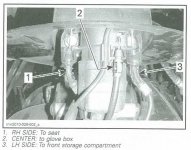2013 RT Limited. Neither my frunk or seat will unlatch from the key or the switch on the dash with Park. The key seems to turn different when I push it down and turn to either seat or frunk. Does the key activate a solenoid and if so where would it be located. I've tried everything. TIA
-
There were many reasons for the change of the site software, the biggest was security. The age of the old software also meant no server updates for certain programs. There are many benefits to the new software, one of the biggest is the mobile functionality. Ill fix up some stuff in the coming days, we'll also try to get some of the old addons back or the data imported back into the site like the garage. To create a thread or to reply with a post is basically the same as it was in the prior software. The default style of the site is light colored, but i temporarily added a darker colored style, to change you can find a link at the bottom of the site.
Frunk and seat, won't open
- Thread starter rwyma
- Start date

